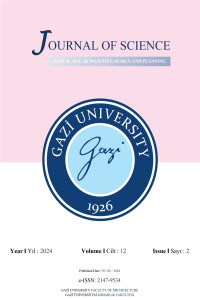Research Article
Aim & Scope
At the national and international level, the journal accepts articles with the following qualifications.
1- Research articles that reflect an original research in the fields of Art, Humanities, Design and Planning with their findings and results and contribute to science.
2- Review articles that review the sufficient number of scientific articles, summarize the subject at the current level of knowledge and technology, evaluate and interpret the findings by comparing them.
The scope of the “Gazi University Journal of Science Part B: Art, Humanities, Design and Planning” comprises such as original research on all aspects of architecture, urban planning, industrial design, landscape architecture, social and humanities and interdisciplinary studies of all these subjects. Original research results, scientific reviews and short communication notes in various fields of Art, Humanities, Design and Planning are considered for publication. It is an international peer reviwed journal. The publication language of the journal is English. Manuscripts previously published in another journal are not accepted. Manuscripts with a suitable balance of practice and theory are preferred. Short communication notes prepared by researchers who would like to share the first outcomes of their on-going, original research work are welcome.
Author Guidelines
Overview
1- The uploaded article should not have been sent to another journal and should not be published. Likewise, the scientific studies sent to the journal should not be in the evaluation stage for publication elsewhere as a published / oral / poster / presentation.
2- While the article is being uploaded to the system, the corresponding author must upload the "Copyright Agreement Part B" with the names and signatures of the other authors, if any, to the DERGİPARK system.
3- Pre-Loading Format; None of the author's names and addresses that contributed to the study should be written in the Part B of the Journal of Science. Thus, the referees will not be able to see which author (s) the study belongs to. (Double Blind Review Process)
4- After at least two referees' opinions are received and the relevant section editor accepts, the uploaded article is accepted.
5- Detailed information about the evaluation and acceptance process of the article can be found at https://dergipark.org.tr/tr/pub/gujsb.
6- The originality and similarity rates of the study are screened by the Turnitin program and only the articles with originality rates below 20% are evaluated.
7- The total text of the article should be between 10-15 pages.
8- Abstract text should not exceed 250 words.
Article Preparation
Abstract
Research articles and reviews should be started with a summary that highlights new information and briefly describes the content of the article. Abbreviations and jargon must not be used. The abstracts should be suitable for abstract format without rewriting. Abstract for a maximum of 250 words should be placed after the address of the author and one blank line. After one blank line from the abstract, key words should be written.
Keywords
Key words reflecting the major features of the work should be inserted. Key words should be written as italic and occured at least three words but no more than five words.
The Text
This is the numbered part of the manuscript which may include the parts: 1. Introduction, 2. Experimental/Theoretical Framework 3. Results and Discussion, 4. References. The text may include sub headings with the following numbering style (2.1, 2.2,…etc.). The minimum and maximum number of pages should be 2 and 15 respectively. If necessary the advisory board may increase the maximum.
Introduction
Every paper must have a concise introduction explaining the state of the topic, and stating clearly what is new in the paper submitted.
Experimental
The experimental methods and the materials used should be described after the introductory paragraphs. Detailed technical descriptions should be restricted to one section of the paper, and not scattered throughout the text. Sufficient information should be given to allow any reasonably experienced worker to carry out the procedure. Detailed descriptions of well-known techniques and equipment are unnecessary, as are simple preparations of reagents or solutions, and lists of common materials. In writing, complete sentences should be used.
Results and Discussion
Preferably these should be treated together to avoid unnecessary repetition. Unsupported elaboration of hypotheses and verbose exposition of ideas should be avoided. Results and Discussion may be presented in different sections.
Acknowledgements
If any support is given to the work by an institution or a person, it should be indicated as acknowledgement in the manuscript. Acknowledgements should be kept as short as possible, and placed at the conclusion of the text.
References
Literature references are to be numbered consecutively and should be grouped together at the end of the paper under the heading “References”. In the text references are quoted by giving the corresponding numbers of the references list as Arabic numerals in square brackets. APA style, which is the international reference writing format, should be used. In scientific articles using footnotes, the references for footnotes should be included in the references at the end of the article.
If the reference is a journal paper: Author surname, first name initial(s), title of the paper, journal name, volume number, pages, year.
Goto, S., Levec, J. and Smith, J.M., “Mass transfer in packed ebds with two-phase flow”, Ind. Eng. Chem. Process Des. Dev . , 14(2): 473-485, (1975).
If the reference is a book: Author surname, first name initial(s), title of the book, volume number, editor(s) (if provided), place of print , page interval, year.
McAdams, W. H., Heat Transmission 2 nd ed. , McGraw Hill , New York, (1942).
If the reference is a printed thesis: Author surname, first name initial(s), title of the thesis, thesis type (MSc. or Ph.D), institute submitted, place, page interval, year.
Tezcan, L., “Mathematical Modeling of Karst Aquifer Systems with the Use of Tritium Isotope”, Phd.Thesis, Hacettepe University Institute of Science and Technology, Ankara, 10-15 (1993).
If the reference is a congress presentation: Author surname, first name initial(s), title of the presentation, name of the congress, seminar or conference, place, page interval, year.
Toppare, L., “4-bromstrien and a-metilstiren Copolimerization with Electrochemical Process”, II. National Macromolecule Symposium, İzmir, 85-96, (1985).
If the reference is a source publication: Author surname, first name initial(s), report name, name of the organization (if the report is prepared by an organization), report number (if applicable), place, page interval, year.
Baran, I. and Kasparek,M., “Marine Turtles Of Turkey; Status Survey 1988 And Recommendations For Conservation And Management”, WWF Report , Heidelberg, 123-130, (1989).
If the reference is a daily magazine or newspaper:
Corliss, Richard, Sept. 13, Pacific Overtures Times, 142(11): 68-70 (1993).
If the reference is For Electronic Encyclopedia and books:
Internet: Bosnia and Herzegovina, In Britannica Online. http://www.-eb.com:180/cgi-bin/g?DocF=micro/79/88.html , (2000).
Articles not yet published should be given as “accepted” or “in press” only if accepted for publication. Otherwise, unpublished articles should be referred to as “submitted for publication”, “in preparation” or “personal communication”, as appropriate.
Figures and Tables
Figures, graphs, photographs and tables in JPG or TIFF format should be given inside (not a seperate page) the manuscript. The photographs should be scanned and submitted as original copies. All figures and tables should be numbered consecutively in Arabic numerals throughout the paper. Footnotes to tables should be with lower-case letters. Line drawings are preferable to photographs. Scanned graphs are less preferred and acceptable only if adequately resolved. Inscriptions should be clearly legible. It is recommended that the letters are 2-3 mm high. Half-tone illustrations, if any, should be well contrasted and trimmed at right angles in the desired final size. Graphs should not be present in large format (e. g. A4 full size), but rather in a typical size of 6—8 cm.
Nomenclature, symbols and abbreviations
In general, the recommendations of the SI units should be followed. Symbols, formulas and equations should be written with great care, capitals and lower case letters being distinguished where necessary. Particular care should be taken in typing mathematical expressions containing superscripts and in proof-reading such equations. Mathematical expressions should be written by an equation editor (Word format) in 9 point size. Indices font should be 8 point size. Each equation in text should be numbered in parenthesis ( ). Unusual symbols employed for the first time should be defined by name in the left-hand margin. Abbreviations require definition when first used.
The authors may recommend 2 arbitrators on request.
Note: Authors may recommend two potential reviewers from different geographical locations. These should be experts in their field, who will be able to provide an objective assessment of the manuscript. Any suggested peer reviewers should not have published with any of the authors of the manuscript within the past five years, should not be current collaborators, and should not be members of the same research institution. Reviewers suggested by authors will be considered alongside potential reviewers recommended by the Editorial Board. Authors must add the name, address and e-mails of reviewers to the part of "Author Comments" during the submission of the manuscript.
Ethical Principles and Publication Policy
JOURNAL ETHICS
Gazi University Journal of Science Part B: Art Humanities Design and Planning has accepted that internationally accepted ethical rules and publication policies should be applied by all parties (editor, referee, author).
GUJSPB observes the publication ethics principles, standards and recommendations set by COPE (Committee on Publication Ethics). As of April 1, 2022, GUJSPB guarantees the publication and quality of the articles in terms of compliance with the ethical rules. Ethical issues will be evaluated in accordance with COPE rules and journal guidelines. The ethical responsibilities of the parties are also specified below.
While the article is uploaded to the system, the "Copyright Transfer Form" filled and signed by all authors and the "Manuscript Title Form" containing the author's information should also be uploaded. In order for an article to be published in the journal, it must be approved for publication by at least two referees. The articles that passed the blind referee process and did not have any missing documents were deemed suitable for publication and sharing in the journal. However, in the publication process or after publication, articles that do not comply with the publication ethics policy of the journal are removed from publication. Journal referees and/or editorial board have the right to request documents related to the work outputs from the authors in the studies they deem necessary. If the required documents are not submitted, the article will be rejected.
If there is a behavior that does not comply with the ethical principles of the parties, an unethical situation of a work sent or published for publication, the journal e-mail address should be informed.
Ethical Responsibilities of Editors
• Editors should strive to improve the quality of publication in the journal.
• Editors should be independent of any commercial institution.
• Editors should be clear about their expectations from reviewers and authors.
• Public interest should be considered in the decisions made in the journal.
• Editors should keep records of each article and correspondence related to the journal electronically or in print.
• Editors should complete their work with impartiality, confidentiality, conflict of interest and peer review processes.
• Editors should manage unethical behavior in accordance with rational ethical rules.
• The articles uploaded to the journal should be checked for compliance with the journal before they are submitted to the referees (at least 2 copies) by the relevant editor. These are the eligibility steps:
o Compliance with spelling rules
o Compliance with the template in shape
o Compliance with its purpose and scope
o Compliance with publication principles
o Compliance with publication ethics
o Scientific quality and originality should be examined.
Ethical Responsibilities of Referees
• The article should be checked in accordance with the journal's guidelines.
• The academic quality and originality of the article should be examined.
• Should not share information about the work with the authors or others.
• Evaluations should be concrete, measured and objective.
• During the evaluation process, the referees should pay attention to the time given to them. If necessary, additional time should be requested.
• In case of copyright infringement and plagiarism, the editor should be informed immediately.
Ethical responsibilities of authors
• Author names should be presented in full.
• Person(s) who did not contribute to the study should not be included as authors.
• Studies that are not covered by the journal should not be submitted.
• Studies involving plagiarism and unethical publishing behavior should not be done.
• There should be no copyright infringement.
• It should not disclose a place/person/institution/organization etc.
• There should be no conflicts of interest.
• Must comply with reporting standards.
• The data used should be available when needed.
• Be open and honest about the results of the study.
• The methodology of the study should be clearly stated.
• Multiple publications should not be made from the same work.
• Appropriate citations and references should be used within the scope of the study.
• The article should not have obvious errors.
• The similarity rate detected before publication should be below 20% (Turnitin).
The authors are responsible for the submitted and published work.
JOURNAL PUBLICATION POLICY
As of 2013, all parts (a, b, c) of Gazi University Journal of Science are published in English and in electronic format, 4 issues per year.
Gazi University Journal of Science Part B: Art Humanities Design and Planning is a double-blind, peer-reviewed, indexed and open access journal. The content of the journal can be accessed online at no cost. Therefore, Gazi University Journal of Science Part B: Art Humanities Design and Planning does not charge any product processing fees (APC) and article submission fees (ASC).
Article finalization period is a maximum of 4 months.
The article (or study) in the evaluation process can be withdrawn through the DergiPark system, provided that all authors send the withdrawal request letter with wet signature. However, the article cannot be sent to another journal before this process is completed. A completed article cannot be withdrawn.
All rights of the published articles belong to Gazi University Journal of Science, Part B: Art Humanities Design and Planning.
Scientific responsibilities of the article belong to the authors.
Price Policy
Article Submission Charges
Gazi University Journal of Science Part B: Art Humanities Design and Planning is a free Open Access Journal (OAJ) and has no article submission charges (ASCs).
Article Processing Charges
Gazi University Journal of Science Part B: Art Humanities Design and Planning is a free Open Access Journal (OAJ) and has no article processing charges (APCs). The published articles can be downloaded freely.
Indexes
Journal Boards
Owner on Behalf of Gazi University
Publishing Manager

Editor in Chief

Dr. Zeynep Yeşim İlerisoy, mimarlık alanında lisans ve lisansüstü düzeyde eğitim-öğretime aktif katkı sunmakta, öğrencilerin analitik ve yaratıcı düşünme becerilerini geliştirmeye yönelik disiplinlerarası yaklaşımlar benimsemektedir. Akademik çalışmalarında özellikle mimarlıkta dijitalleşme, sürdürülebilir tasarım ve kullanıcı odaklı mekân kurguları üzerine yoğunlaşmakta; yenilikçi teknolojilere ilgi duymaktadır. Farklı üniversitelerde çeşitli akademik ve idari görevler üstlenmiş; çok disiplinli, ulusal ve uluslararası işbirlikli araştırma projelerinde görev almıştır. Hem akademik üretimi hem de yönetsel deneyimiyle mimarlık eğitimine ve araştırma kültürüne katkı sunmaya devam etmektedir.
Associate Editors


Gazi Ünivarsitesi Mimarlık Bölümünden mezun oldu. Aynı üniversitede Restorasyon Bilim Dalında yüksek lisans ve doktorasını tamamladı. İki yıl ABB KUDEM’de restoratör mimar olarak görev yaptıktan sonra altı yıl Gazi Üniversitesi’nde araştırma görevlisi olarak çalıştı. 2018-2023 yılları arasında Konya Necmettin Erbakan Üniversitesi Mimarlık Bölümü’nde çalıştı. 2023 yılında Gazi Üniversitesi Mimarlık Bölümü'ne geçti, 2024 yılında aynı üniversitede doçent unvanını aldı. Çeşitli bilimsel araştırma projelerinde Balkan ülkelerindeki Osmanlı vakıf eserlerinin tespiti ve koruma çalışmalarına katılmıştır. Rodos Adası’nda Osmanlı Mirası adlı çift yazarlı bir kitabı bulunmaktadır.
Editors



Izzettin Kutlu started his academic career at Avrasya University between 2017-2018. Currently working at Mardin Artuklu University since 2019. Graduated in 2016 from Hatay Mustafa Kemal University Faculty of Architecture with the first degree and started his post-graduate education at Gazi University in the same year. After completing master program in 2019, started PhD education in the same year and completed PhD research in 2023 with the thesis titled "Evaluation of the Use of Photogrammetric Modelling Technique in Structural Analysis of Historical Buildings on the Examples of Melik Mahmut Mosque and Mardin Great Mosque of Artuqid Period". Research interests include historical environments, conservation and structural conditions of historical buildings.




Editorial Board



She graduated from the Middle East Technical University (METU) Faculty of Architecture, Department of Architecture, earning her bachelor's degree in 1986, master's degree in 1989, and Ph.D. in 1998. Between 1986 and 1988, she worked as a project manager and designer on various projects at the MİMOR Architecture office with her father, architect Özhan Sökmen. In 1987, she co-founded Uludağ Architecture with Orhan Uludağ, and since then, they have collaboratively carried out architectural design and implementation projects. They have participated in numerous national and international architectural and urban design competitions and exhibitions. In 1993–1994, she worked as a part-time lecturer at Bilkent University's Faculty of Fine Arts, Department of Interior Architecture and Environmental Design, and later continued her academic career at Gazi University's Faculty of Architecture. During the 2002–2003 academic year, she served as a visiting professor in Antwerp, Belgium, at the Henry Van De Velde Higher Institute of Architectural Sciences, where she led an international architectural project studio and taught a graduate-level course. Since 2006, she has been working at Gazi University's Faculty of Architecture, Department of Architecture, first as an Associate Professor and, since 2013, as a full Professor. Between 2007–2010 and 2013–2015, she served as Vice Dean of the same faculty and held the position of Dean from 2015 to 2016. Her academic work includes national and international publications in the fields of architectural design, design theories and education, urban landscapes, and urban history. She is also a founding member of the Architectural Accreditation Board Association (MİAK) and actively contributes to efforts aimed at improving the curricula and educational standards of architecture programs in Turkey.
Ebru V. Öcalır graduated from Gazi University, Department of City and Regional Planning in 1993. She completed her master’s degree in Regional Planning at Middle East Technical University in 1996. In 1999, with a scholarship from the Council of Higher Education (YÖK), she went to Austria and earned her Ph.D. in 2003 at Vienna University of Technology, Faculty of Architecture, Department of Transport Planning and Traffic Engineering. With the same YÖK scholarship, she continued her postdoctoral studies at Vienna University of Technology between October and December 2010, focusing on the modeling of transport and land-use relationships. She is currently a faculty member at Gazi University, Department of City and Regional Planning. Her research areas include transportation and transport systems planning, urban planning, sustainability, Geographic Information Systems (GIS), and Decision Support Systems. She has authored two international books on these subjects.


Prof. Dr. Sibel ECEMİŞ KILIÇ
Doğum Yeri/Tarihi :Çamardı, 25.02.1975
Kadro Ünvanı ve Aldığı Tarih :Profesör, 2015
Kadrosunun Bulunduğu Birim :Dokuz Eylül Üniversitesi, Mimarlık Fakültesi, Şehir ve Bölge Planlama Bölümü Bölge Planlama Anabilim Dalı
Yabancı Dil :İngilizce ( YÖKDİL: 87,5 / 2022 Yılı )
Lisans :Dokuz Eylül Üniversitesi Mimarlık Fakültesi Şehir ve Bölge Planlama Bölümü, Temmuz 1996
Yüksek Lisans :Dokuz Eylül Üniversitesi Fen Bilimleri Enstitüsü Şehir ve Bölge Planlama Anabilim Dalı, Ağustos 1999
Doktora :Dokuz Eylül Üniversitesi Fen Bilimleri Enstitüsü Şehir ve Bölge Planlama Anabilim Dalı, Nisan 2004
Yardımcı Doçent :Dokuz Eylül Üniversitesi Mimarlık Fakültesi, Mart 2005
Doçent :Dokuz Eylül Üniversitesi Mimarlık Fakültesi (Ünvan: Nisan 2010 ) (Kadro: Şubat 2011 )
Başlıca Eserler:
SCI, SSCI ve AHCI İndekslerine Giren Dergilerde Yayınlanan Makaleler
Spatial Reflections of PopulationMovements in Gokceada and Sustainable Tourism, EcemişKılıç S.,AydoğanM., EUROPEANPLANNINGSTUDIES, cilt.22, sa.11, ss.2213-2230,2014 (SSCI)
Proposals for Regional Administrative Structure and Planning in Turkey, ECEMİŞKILIÇS., EUROPEANPLANNINGSTUDIES, cilt.17, sa.9, ss.1283-1301,2009 (SSCI)
Preservation plan applications for the historical city centre, Kemeralti (Izmir, Turkey), ECEMİŞKILIÇS., EUROPEANPLANNINGSTUDIES, cilt.16, sa.2, ss.253-276,2008 (SSCI)
Prof. Dr. Neslihan Dostoğlu, 1973 yılında Robert Kolej’den, 1978’de O.D.T.Ü. Mimarlık Bölümü’nden mezun oldu. Aynı Bölüm’de yüksek lisans derecesini aldıktan sonra eğitimini sürdürmek üzere A.B.D.’ye gitti ve 1986’da mimarlık alanında doktorasını tamamladı.
Türkiye’ye döndükten sonra 1988-1990 yılları arasında Anadolu Üniversitesi’nde, 1994 yılından sonra da Uludağ Üniversitesi Mimarlık Bölümü’nde akademik kariyerine devam etti. 1997 yılında doçent, 2003 yılında profesör ünvanını alan Dostoğlu, Uludağ Üniversitesi’nde onaltı yıl görev yaptı. Ayrıca, 1998-2008 yılları arasında Bursa Kültür ve Tabiat Varlıklarını Koruma Kurulu üyesi ve başkanı oldu.
2010 yılında İstanbul Kültür Üniversitesi Mimarlık Bölümü akademik kadrosuna katılan ve halen İstanbul Kültür Üniversitesi Mimarlık Fakültesi Dekanı olan Dostoğlu, 2019-2021 döneminde Mimarlık Fakültesi Dekanları Konseyi (MİDEKON) Dönem Başkanı olarak görev yaptı. Dostoğlu, ayrıca Bursa’nın UNESCO Dünya Miras Listesi’ne adaylık sürecinde 2011 yılında Alan Başkanı olarak atandı ve Bursa’nın 2014 yılında UNESCO Dünya Miras Listesi’nde yer almasında önemli rol oynadı.
Dostoğlu’nun yurtiçinde ve yurtdışında yayımlanmış kitapları, kitap editörlükleri, kitap bölümleri, önemli dergilerde yayımlanmış makaleleri, kongre bildirileri ile çeşitli mimari proje yarışmalarında ve meslekte başarı ödülleri bulunmaktadır.


Born in 1964 in Trabzon, İlkay Özdemir graduated from the Department of Architecture at KTÜ (Karadeniz Technical University) in 1985. He completed his Master's degree at the Institute of Science at the same university with a thesis titled “A Study on Living Space Accessories” in 1988, and his Doctorate in 1994 with a thesis titled “The Concept of Spatial Organization in the Evaluation of Architectural Space: Living Spaces in Housing.” In 1996, he was appointed Assistant Professor to the Building Information Department of KTÜ Architecture. In 2004, he spent three months at Liverpool Hope University in the UK for research and analysis, and language instruction. He received the title of Associate Professor in 2008, and Professor in 2014.
She served intermittently as Vice Dean of the KTU Faculty of Architecture between 2009 and 2014, as Head of the KTU Department of Architecture between 2014 and 2017, and as Dean of the KTU Faculty of Architecture between 2017 and 2021. She served on the Board of Directors and Faculty Councils between 2009 and 2021.
She has numerous articles, book chapters, and papers presented at scientific meetings, both internationally and nationally. She has served as a director, researcher, and advisor on 12 scientific research projects, including those sponsored by TUBITAK and BAP. She has also completed 13 master's theses and 6 doctoral theses under her supervision. She currently continues her academic work as a faculty member in the KTU Department of Architecture. She is a member of the TMMOB Chamber of Architects, MimED, and the MİAK-MAK Visiting Team.

KTÜ Mühendislik-Mimarlık Fakültesi, Mimarlık Bölümü’nde 1989 yılında lisans eğitimini tamamlamış, KTÜ Fen Bilimleri Enstitüsü Mimarlık Anabilim Dalı’ndan "Türkiye briketlerinin ısıl davranışları" başlıklı tezi ile 1994 yılında yüksek lisans ve "Yapıların projeleri üzerinden yangın güvenlik analizinin bilgisayar modeli ve programı" başlıklı tezi ile 1999 yılında doktora derecelerini almıştır. 1995-2000 yılları arasında KTÜ Mimarlık Bölümü’nde araştırma görevlisi, 2001-2002 yılları arasında KTÜ İçmimarlık Bölümü’nde öğretim görevlisi, 2003-2008 yılları arasında KTÜ Mimarlık Bölümü’nde Yardımcı Doçent ve 2009-2011 yılları arasında Doçent olarak görev yapmıştır. 2003-2004 yıllarında University of New South Wales-The Faculty of Building Environment-Sydney’de misafir öğretim üyesi olarak araştırmalarını sürdürmüştür. 2008-2011 tarihleri arasında KTÜ Yapı Bilgisi Anabilim Dalı Başkanlığı ve 2009 yılında KTÜ Mimarlık Bölüm Başkan Yardımcılığı görevlerini yürütmüştür. Eylül 2010-Şubat 2011 tarihleri arasında Farabi Değişim Programı ile Eskişehir Osmangazi Üniversitesi Mühendislik-Mimarlık Fakültesi, Mimarlık Bölümü’nde öğretim üyesi olarak görev yapmıştır. Kasım 2011 tarihinden itibaren Gazi Üniversitesi Mimarlık Fakültesi Mimarlık Bölümü’nde Doçent olarak göreve başlamış, Ocak 2015 tarihinde ise Profesör unvanını almıştır. Aynı zamanda 2011-2016 yılları arasında Gazi Üniversitesi İçmimarlık Bölüm Başkanlığı ve 2017-2020 yılları arasında Senato Üyeliği görevlerini yürütmüştür. Akademik görevlerinin yanı sıra Şubat 2024 tarihinden itibaren TMMOB Mimarlar Odası Ankara Şubesi 2. Başkanı olarak görev yapmaktadır. Yapı sektöründe yer alan firmalar, dernekler, vakıflar ve Bakanlıklar ile işbirliği çerçevesinde çok sayıda mesleki eğitimler vermiş, çalıştaylarda görev almış ve yarışma jürilerine katkılar sunmuştur. Çalışma alanları olan Mimari Tasarım ve Yapı Fiziği kapsamında yapılarda yangın güvenliği, enerji etkin yapı tasarımı, sürdürülebilir mimarlık, adli mimarlık konularında ulusal ve uluslararası makaleleri, araştırma projeleri, kitapları, bildirileri bulunmaktadır.


Gizem Özkan Üstün has been working as a faculty member at the Faculty of Architecture, Bolu Abant Izzet Baysal University, Turkey, since 2024. She is the Head of the Architecture Department at the same university. She received her Ph.D. in Architecture from Gazi University in 2024, where she also completed her master’s degree. Her academic interests include architectural design, design education, architectural theory, and philosophy. Her research focuses on the intersections of architecture with culture, identity, and critical thinking. In addition to her teaching responsibilities, she actively contributes to academic publications and interdisciplinary projects, aiming to bridge theoretical inquiry with contemporary architectural practices.



Technical Editors







